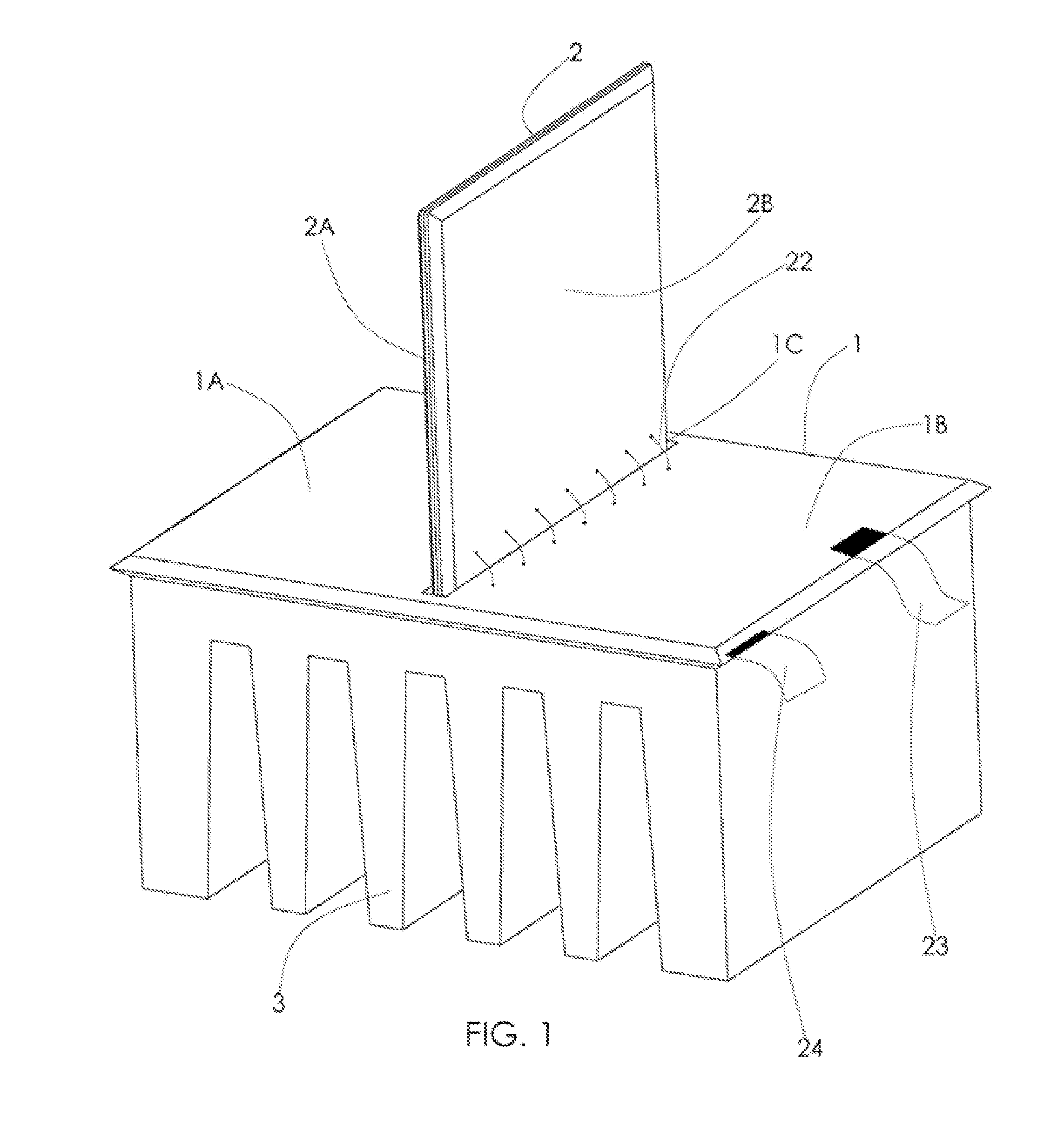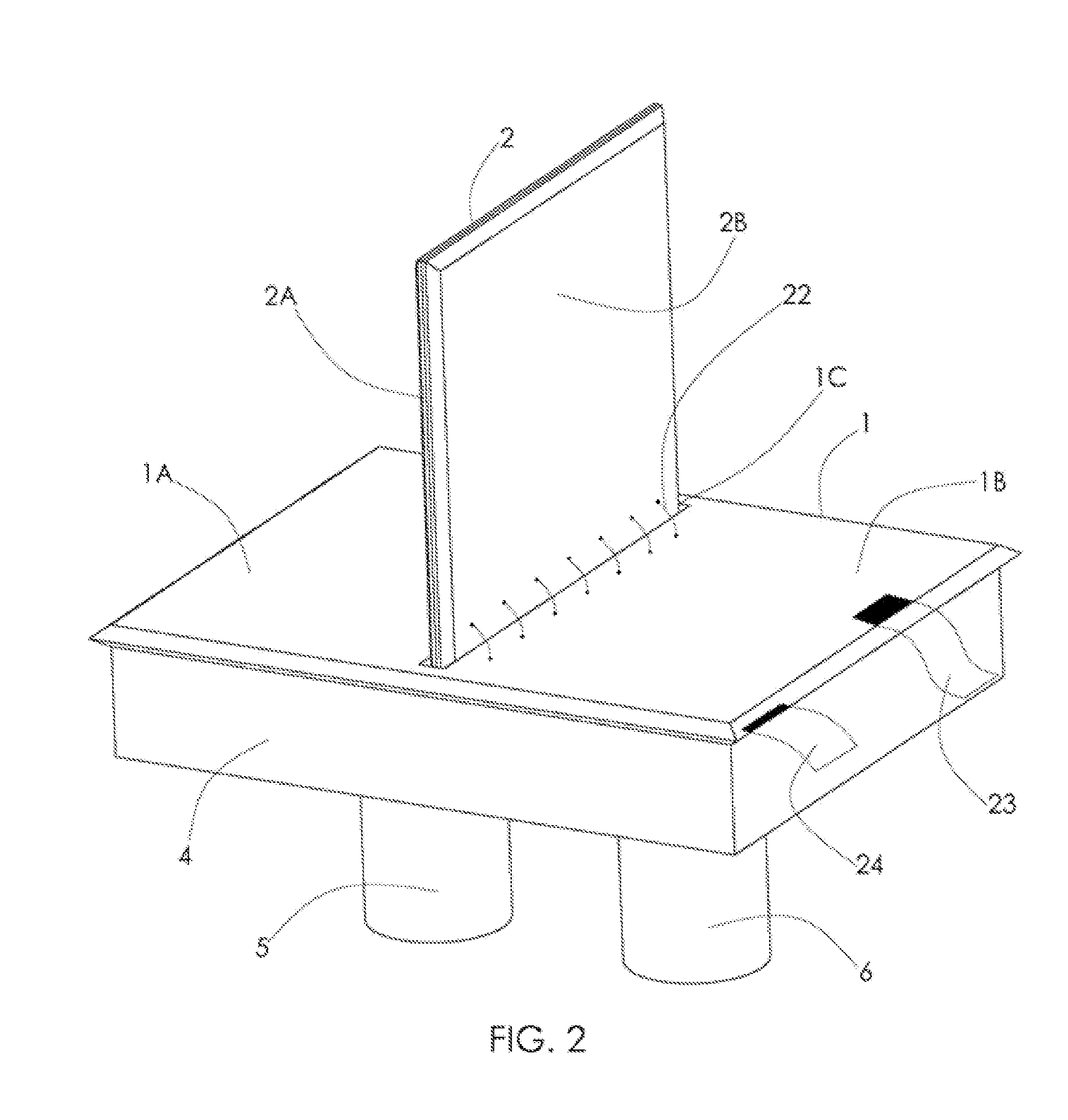3-D Solar Cell Device For A Concentrated Photovoltaic System
a solar cell and concentrated technology, applied in semiconductor devices, pv power plants, hybrid energy generation of thermal-pv hybrids, etc., can solve the problems of low solar energy efficiency, and low reliability of tracking systems, so as to improve reliability, reduce production costs, and high solar energy efficiency
- Summary
- Abstract
- Description
- Claims
- Application Information
AI Technical Summary
Benefits of technology
Problems solved by technology
Method used
Image
Examples
first example
Illustrative First Example
[0066]FIG. 1 shows an assembly view of a 3-D solar cell device. The 3-D solar cell structure comprises a base solar cell chip 1, a vertical solar cell chip 2 and a mounting block 3. The base solar cell chip 1 comprises a face of an n-type solar cell 1A and 1B, and a groove 10. The vertical solar cell chip 2 comprises a face of n-type solar cell 2A and a face of an n-type solar cell 2B. The vertical solar cell chip 2 can be formed by bonding two pieces of a solar cell back-to-back so that the n-type face of the vertical solar cell 2 shows on the n-type face of 2A and 2B. Then, the vertical solar cell chip 2 is interconnected to the groove 10 to form a perpendicular vertical wall shown in FIG. 1. The n-type faces 1A, 1B, 2A and 2B are connected by conducting wires 22 for an electrical connection on all n-type surfaces. Sunlight is focused by a lens element such as a convex or Fresnel lens to the faces of 1A, 1B, 2A and 2B as the sun travels from east to west....
second example
Illustrative Second Example
[0067]FIG. 2 shows an assembly view of a 3-D solar cell device with liquid cooling channels attached on the backside of all solar cell surfaces. The 3-D solar cell structure comprises a base solar cell chip 1, a vertical solar cell chip 2, a mounting block 4, and an input and output port 5 and 6. All components in FIG. 2 are the same as those described in FIG. 1 of Section 6.1; however, the base solar cell chip 1 is designed with a liquid cooling channel that is etched on the backside of the base solar cell chips 1, or a separate liquid cooling channel is bonded to the backside of the solar cell chips 1. The vertical solar cell chip 2 is also formed by bonding a silicon chip with liquid cooling channels, or two pieces of the solar cell are bonded together on the p-type side where the solar chip is etched to form liquid cooling channels. Bonding of a liquid cooling channel on the solar cell chips 1 and 2 maintains the solar cell efficiency as increasing sol...
third example
Illustrative Third Example
[0068]FIG. 3 shows an assembly view of a 3-D solar cell device with two corner-cube configurations. The basic construction of the 3-D solar cell is the same as described in section 6.1; however, a back solar cell chip 7 is added to the solar cell chips 1 and 2 forming a perpendicular plane to these solar chips. The vertical solar cell chip 2 is added to collect all sunlight throughout daytime operations which eliminates the need of a sunlight tracking system. The detailed functionality of the vertical solar cell chip 2 will be described in a later section. In addition to the changing sun position during daily operations, the altitude of the sun position is also changed by seasonal changes and the solar cell has to track the sun position for maximum generation of solar electricity. To compensate for the seasonal position change, the back solar cell chip 7 is added to accommodate for the seasonal adjustment. Adding the vertical solar cell chip 2 and the back ...
PUM
 Login to View More
Login to View More Abstract
Description
Claims
Application Information
 Login to View More
Login to View More - R&D
- Intellectual Property
- Life Sciences
- Materials
- Tech Scout
- Unparalleled Data Quality
- Higher Quality Content
- 60% Fewer Hallucinations
Browse by: Latest US Patents, China's latest patents, Technical Efficacy Thesaurus, Application Domain, Technology Topic, Popular Technical Reports.
© 2025 PatSnap. All rights reserved.Legal|Privacy policy|Modern Slavery Act Transparency Statement|Sitemap|About US| Contact US: help@patsnap.com



